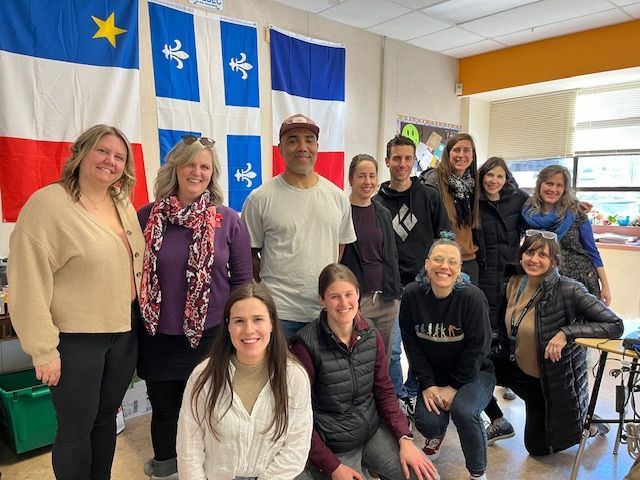SD 22 - L'intégration de l'approche neurolinguistique en immersion française tardive
- Joanne Brunel, Facilitatrice du Réseau de l'Intérieur sud

- May 19, 2023
- 2 min read
Updated: Jun 6, 2023
Dans les classes d’immersion tardive à SD22, l’approche neurolinguistique est intégré dans les stations de littératie. Les principes de cette méthode pédagogique incluent développer la capacité à communiquer dans des situations authentiques dès le début de l’acquisition de la langue. De la même manière, l’accent est mis sur l’apprentissage de la parole avant d’apprendre à lire et écrire dans la deuxième langue. Au long de notre courte observation, j’ai entendu l’expression « si je peux le dire, je peux l’écrire » utilisée souvent lorsque M. LeBlanc s’adressait aux petits groupes.
Pour les stations de littératie dans les classes de Erin Chow et Karyn Godard, les élèves sont regroupés selon leur niveau de lecture. Un avantage de regrouper les élèves en fonction de leurs capacités de lecture est qu’ils peuvent travailler avec un enseignant.e pour progresser leur compréhension d’un texte.
Chaque station fonctionnait différemment. Par exemple, une station se concentre sur la compréhension du vocabulaire dans un texte. Dans une autre station, le groupe tire une carte avec un sujet de conversation et doit communiquer oralement entre eux de ce sujet (par exemple, quel est votre sport préféré et pourquoi?). Dans une des stations qui porte sur les principes de l’approche neurolinguistique, les élèves communiquent oralement puis ils mettent leurs idées sur papier.
Il est certain que ce qui se passe dans les classes de Karyn Godard et Erin Chow est une façon fantastique d’avancer les compétences linguistiques des élèves de l’immersion tardive. Merci Karyn, Erin, et M. LeBlanc!
SD 22 – Integrating the neurolinguistic approach in Late French Immersion
In late immersion classes at SD22, literacy stations have been created based on the neurolinguistic approach. The principles of this pedagogical method include developing the ability to communicate in authentic situations from the very beginning of language acquisition. Similarly, the emphasis is on learning to speak before learning to read and write in the second language. Throughout our brief observation, I heard the phrase “if I can say it, I can write it” used often when M. LeBlanc was speaking to small groups.
For the literacy stations in the classes of Erin Chow and Karyn Godard, students are grouped according to their reading level. One benefit of grouping students according to their reading abilities is that they can work with a teacher to advance their understanding of a text.
Each station operated differently. For example, one station focuses on understanding vocabulary in a text. In another station, the group draws a card with a topic of conversation and must communicate orally with each other about this topic (eg, what is your favorite sport and why?). In one of the stations which focuses on the principles of the neurolinguistic approach, students communicate orally and then put their ideas on paper.
It is certain that the approach used by Karyn Godard and Erin Chow advances the language competencies of late French immersion students in authentic settings. Thank you Karyn, Erin, and M. LeBlanc!

Here's a video showing the neurolinguistic approach in action:




Comments